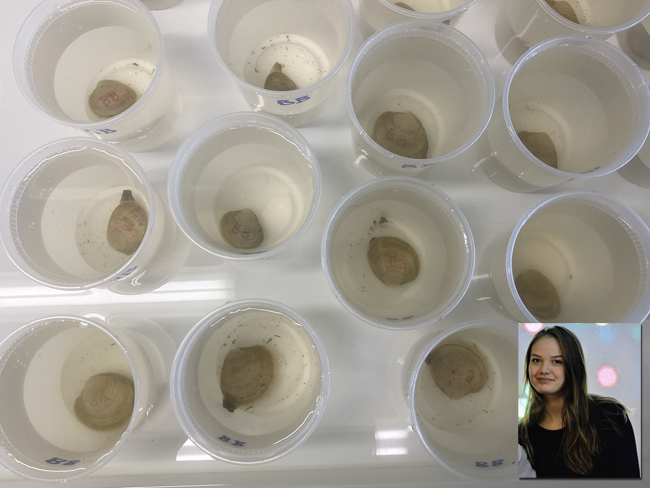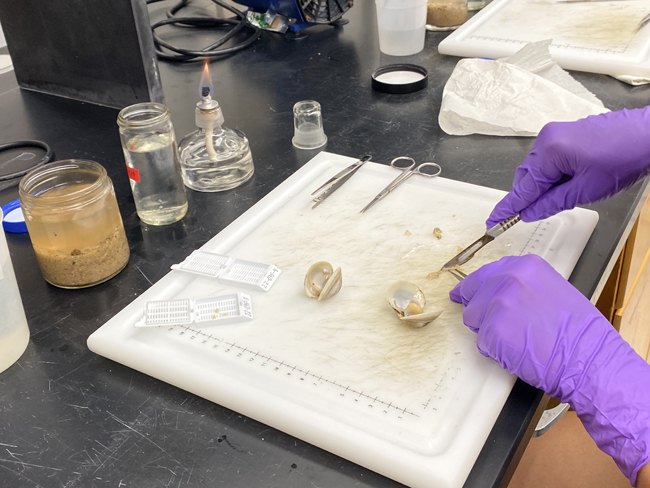
Jade Wu (inset), New York Sea Grant's Community Engaged Internship Fellow for Summer 2022, spent a day at Cornell Cooperative Extension of Suffolk County's Shellfish Hatchery observing an attempt to spawn the resilient strains pictured here. Learn more about Sea Grant's multi-year regional Hard Clam Hub project at www.hardclamhub.org.
— By Jade Wu, NYSG's Summer 2022 CEI Intern
Stony Brook, NY, August 9, 2022 - This summer I had the opportunity to be a part of the Sea Grant Community Engaged mentorship program as the communications fellow on the Hard Clam Selective Breeding project.
This was my first mentorship and it felt like the perfect first experience. As a communications fellow, my role was to create products that communicated insightful information about the Hard Clam project to stakeholders. In order to carry out these tasks, it was important to meet with the collaborators in this project to hear their voices and understand their work. Sending emails, hosting zoom calls, soliciting feedback, working on multiple proofs, building relationships, building interpersonal skills and professional development were all incorporated into this fellowship!
A nice aspect of this mentorship was the weekly professional development zoom meetings for interns to learn about various topics and to socialize with my peers and mentors across the United States. My favorite meeting was hosted by Mona Behl and Sarah Kolsar where they talked about building our personal brands. This discussion focused largely on self-development and reflection; things I find to be very important.
Within 10 weeks, I was able to work on 3 different products: a script for a 3-minute video, a descriptive brochure, and a project glossary. The video script summarizes project milestones, accomplishments and additional information about the science applied. The brochure will be used in public relations efforts and describes the “who, what, why and how” for this research collaborative. I learned that creating these communication products involves continuous editing and revision after receiving feedback from collaborators and my mentor. This team effort helped me to appreciate the importance and value in obtaining multiple perspectives. This process also challenged me to incorporate everyone's feedback and make decisions on how to edit the information in a way that is mindful of the video runtime without compromising the context of the story. This training allowed me to build my interpersonal and writing skills. As a communicator for this project, my main goal is to simplify information in a way that is understandable to the reader.

A batch of clams in a water bath from the CCE Hatchery at Southold, Long Island.
I spent a day in the field visiting the Cornell Cooperative Extension of Suffolk County (CCE) Hatchery facility in Southold, Long Island, where I observed the spawning of hard clam strains being developed under the project. I learned that research requires patience, precision, and critical thinking. This was not the only time I was able to visit a research facility in my time under this CEI program, and I also had the opportunity to observe the research being conducted in the Marine Animal Disease Laboratory at Stony Brook University. Here I interviewed graduate students about their research, as well as, become familiar with their academic studies and how they got into their discipline. Both experiences were very fascinating to me for several reasons.

A graduate student running a clam diagnostic at the Marine Animal Disease Laboratory.
Before this mentorship experience, I ruled out any interest in a research path because I was scared and intimidated by not being able to carry out such work. Having the opportunity to observe labs, read a research project proposal, and speak with lead Principal Investigators made me realize that I wasn’t allowing myself to be open to this path. One of the most valuable lessons from this experience is not allowing the fear of failure to dictate my future academic path – especially in the STEM field. It is easy to feel intimidated, but I find when I push myself to learn, it allows me to overcome my fear and make better decisions.
Overall, from this experience I am most grateful for the people I have worked with and gotten to know. Attending the Sea Grant 50th anniversary was a great experience to see the community within this program and how Sea Grant involves so many different areas of specializations and projects. This program brings many different people together from college students to state and federal officials, to marine specialists and many more. I am very thankful for this opportunity, and I am excited about what is to come.
More Info: New York Sea Grant
New York Sea Grant (NYSG), a cooperative program of Cornell University
and the State University of New York (SUNY), is one of 34 university-based
programs under the National Oceanic and Atmospheric Administration’s
National Sea Grant College Program.
Since 1971, NYSG has represented a statewide network of integrated
research, education and extension services promoting coastal community
economic vitality, environmental sustainability and citizen awareness
and understanding about the State’s marine and Great Lakes resources.
Through NYSG’s efforts, the combined talents of university scientists
and extension specialists help develop and transfer science-based
information to many coastal user groups—businesses and industries,
federal, state and local government decision-makers and agency managers,
educators, the media and the interested public.
The program maintains Great Lakes offices at Cornell University, SUNY
Buffalo, SUNY Oswego and the Wayne County Cooperative Extension office
in Newark. In the State's marine waters, NYSG has offices at Stony Brook
University in Long Island, Brooklyn College and Cornell Cooperative
Extension in NYC and Kingston in the Hudson Valley.
For updates on Sea Grant activities: www.nyseagrant.org has RSS, Facebook, Twitter, Instagram, and YouTube links. NYSG offers a free e-list sign up via www.nyseagrant.org/nycoastlines for its flagship publication, NY Coastlines/Currents, which is published quarterly.